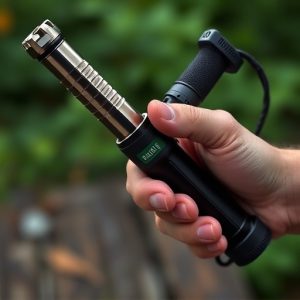Mastering Self-Defense: The Essential Guide to Using an Expandable Baton
An expandable baton serves as a versatile and practical self-defense tool, combining ease of carry …….
An expandable baton serves as a versatile and practical self-defense tool, combining ease of carry with effective defensive capabilities. Unlike fixed batons, it extends to various lengths on demand, offering users a tactical advantage by maintaining a safe distance from threats. The quality of materials—such as stainless steel or aluminum—ensures the baton's durability and reliability under pressure. A secure locking mechanism prevents slippage during confrontations. Its compact size for discreet carry makes it a convenient choice for personal safety. It's essential to comply with local laws regarding self-defense tools, and regular training is necessary to use the expandable baton proficiently, ensuring it becomes an intuitive extension of the user in defensive scenarios. Mastery requires understanding both the technical aspects of deployment and application and the legal framework governing self-defense mechanisms to avoid any post-incident legal complications. Users should be well-versed in the laws specific to their jurisdiction concerning carrying and using such tools, which include statutes on ownership and usage restrictions for responsible use.
When considering personal safety measures, a self-defense expandable baton emerges as a prudent choice for many individuals. This article delves into the practicalities and nuances of wielding such a tool effectively. We’ll explore its components, operation, and the critical training and legal guidelines that accompany it in “Understanding the Self Defense Expandable Baton: A Comprehensive Guide.” Subsequently, we’ll enhance your understanding with “Maximizing Effectiveness with a Self Defense Expandable Baton: Training and Legal Considerations,” ensuring you are well-informed on both the physical and legal aspects of this self-defense tool.
Understanding the Self Defense Expandable Baton: A Comprehensive Guide
An expandable baton serves as a versatile and effective tool for personal self-defense, offering a balance between accessibility and effectiveness in deterrence and protection. Unlike traditional fixed batons, the self-defense expandable baton is designed with a spring-loaded mechanism that allows it to extend to a longer length when needed, providing a reach advantage and enabling users to maintain a safe distance from an assailant. This feature not only extends its utility as a defensive weapon but also helps in managing potential confrontations by giving the user time to react and respond appropriately.
When considering the acquisition of an expandable baton for self-defense, it’s crucial to evaluate factors such as the material composition, durability, size when retracted for concealed carry, and the ease with which it can be deployed in high-stress situations. High-quality expandable batons are typically crafted from durable materials like stainless steel or aluminum for longevity and are designed to extend with a reliable locking mechanism to prevent accidental collapse during use. Additionally, their compact form when closed allows for easy transportation and storage, making them an ideal choice for individuals who prioritize personal safety without compromising on convenience. Users should also familiarize themselves with local laws and regulations regarding the carry and use of such self-defense tools to ensure compliance and legal protection. Regular training and practice are essential to effectively wield an expandable baton, ensuring proficiency in its deployment and application during unexpected encounters.
Maximizing Effectiveness with a Self Defense Expandable Baton: Training and Legal Considerations
When incorporating a self-defense expandable baton into your personal safety arsenal, it is imperative to maximize its effectiveness. Effective training is crucial for mastering the use of this tool in self-defense situations. Proper handling ensures that the baton becomes an extension of your hand and mind, allowing for precise strikes while minimizing the risk of accidental injury. Training should encompass not only the technical aspects of deployment and application but also situational awareness and de-escalation techniques. This comprehensive approach enables users to respond appropriately to threats, ensuring they can defend themselves without escalating violence unnecessarily.
Moreover, legal considerations are a vital aspect when considering the use of an expandable baton for self-defense. Laws vary by jurisdiction, and it is essential to be well-versed in local regulations governing self-defense mechanisms. Understanding the legal framework under which the baton can be used defensively will prevent potential legal complications post-incident. Knowledge of self-defense statutes, carrying laws, and restrictions on where and how a baton can be employed are all critical components of responsible ownership and use. By staying informed and adhering to legal guidelines, individuals can ensure that they use their self-defense expandable baton in a manner consistent with the law, thereby protecting themselves and avoiding unintended legal consequences.


